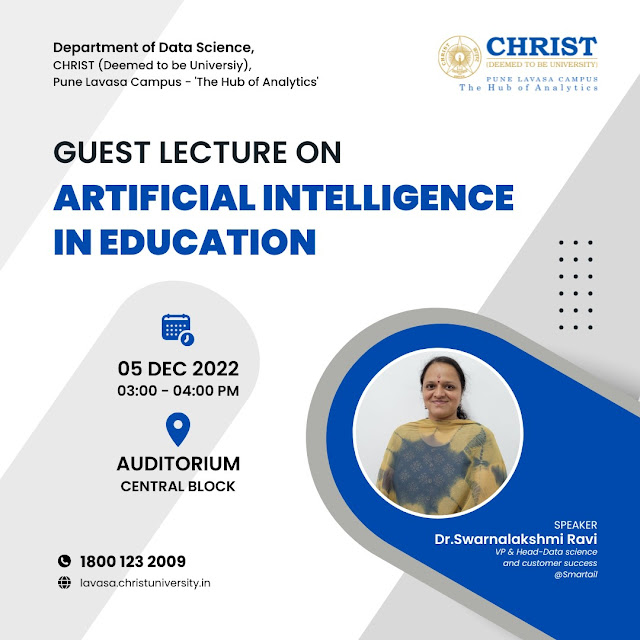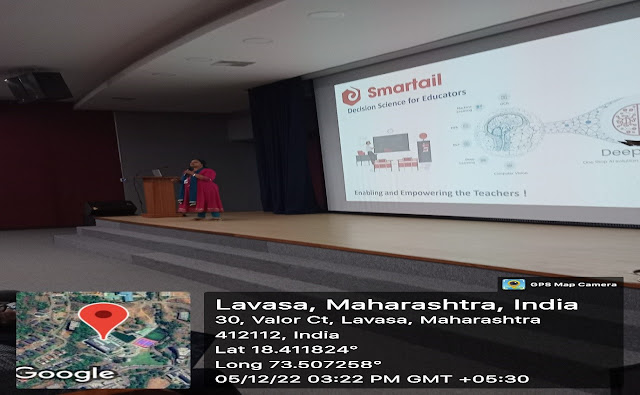Guest Lecture on “Artificial Intelligence in Education”
A lot of development has been made in the field of Artificial Intelligence and the progress can be seen. AI is a dynamic tool used across industries for better decision making, increasing efficiency and eliminating repetitive work. The session started with the application areas such as Healthcare, Automobile, Banking and Finance, Surveillance, Social Media, Entertainment, Education, Space Exploration, Gaming, Robotics, Agriculture and E-Commerce that are focused by many researchers in the field of AI. AI analytics uses machine learning algorithms to constantly monitor and analyze huge amounts of data, automating the time-consuming work normally done by a data analyst. The process of taking raw data and applying some form of analytical technique in order to find meaningful patterns in the data was presented. How the field of analytics can be further broken down into several stages such as Descriptive analytics, Diagnostic analytics, Predictive analytics and Prescriptive analytics and the role of all these in the field of education was presented.
Descriptive Analytics is the examination of data or content, usually manually performed, to answer the question “What happened?” or What is happening? characterized by traditional business intelligence (BI) and visualizations such as pie charts, bar charts, line graphs, tables, or generated narratives. Diagnostic analytics is a form of advanced analytics that examines data or content to answer the question, “Why did it happen?” It is characterized by techniques such as drill-down, data discovery, data mining and correlations. The term predictive analytics refers to the use of statistics and modeling techniques to make predictions about future outcomes and performance. Predictive analytics looks at current and historical data patterns to determine if those patterns are likely to emerge again. This allows businesses and investors to adjust where they use their resources to take advantage of possible future events. Predictive analysis can also be used to improve operational efficiencies and reduce risk. Prescriptive analytics has been called “the future of data analytics,” and for good reason.
This type of analysis goes beyond explanations and predictions to recommend the best course of action moving forward. It’s especially useful in driving data-informed decision-making. How often the most difficult and valuable stage in analytics in determining how exactly we can make the desired outcome become a reality was discussed.
The fundamental difference Between AI Analytics and Traditional Analytics, how centuries-old statistical modeling techniques, AI and machine learning are now transforming the field of analytics by offering a level of speed, scale and granularity that’s humanly impossible was discussed as case study. Business Use Cases for AI Analytics in the field of education using one of their products were presented. How AI Provides Competitive Advantage To Modern Analytics Stack was also discussed. How DeepGrade is an ideal app for both Tutors and learners where teachers would be able to record video of their lessons and publish to learners was demonstrated. The AI concepts behind the scene of designing their product and how it is helpful for teachers in changing their evaluation time into a productive time was explained. The deviations and the places where manual intervention is needed in DeepGrade and the method of bridging the gap was also discussed.
The students gained an idea of how artificial intelligence predictive and perspective analytics can be used in designing deep learning applications on handwritten characters.
The students gained an idea of how artificial intelligence predictive and perspective analytics can be used in designing deep learning applications on handwritten characters.







Very informative and helpful blog with very descriptive information. For more information you contact the best artificial intelligence development company.
ReplyDeleteNIILM’s innovation is inspiring. This article showcases how the AI Campus at NIILM University is setting benchmarks in education.
ReplyDelete